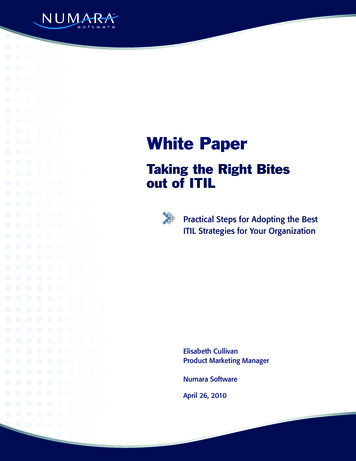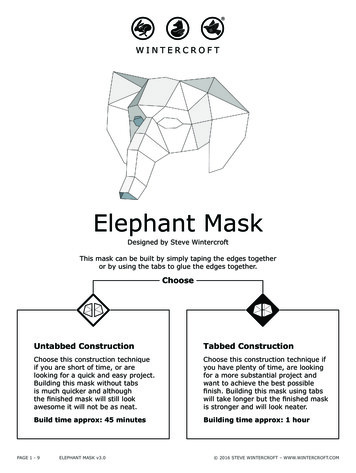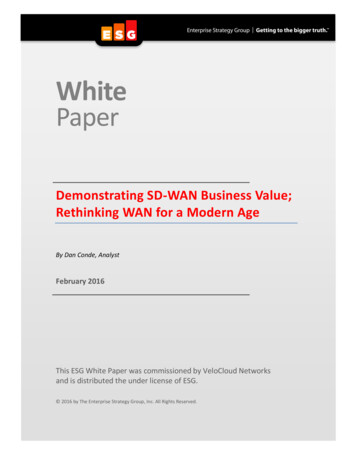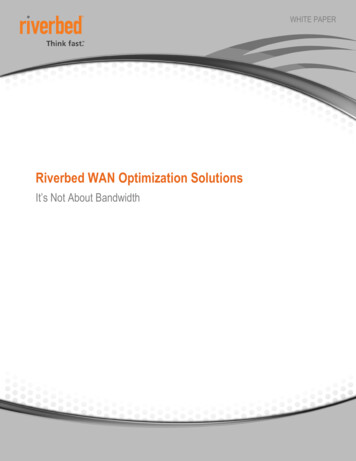
Transcription
White PaperTaking the Right Bitesout of ITILPractical Steps for Adopting the BestITIL Strategies for Your OrganizationElisabeth CullivanProduct Marketing ManagerNumara SoftwareApril 26, 2010
White PaperTaking the Right Bites out of ITILPractical Steps for Adopting the Best ITILStrategies for Your OrganizationExecutive SummaryThe IT Infrastructure Library (ITIL ) is widely accepted as the defacto set of best practices for IT Service Management. Thousands oforganizations around the world have adopted ITIL’s philosophies andguidelines, in one way or another; and an entire ecosystem of ITIL tools,certifications and consultants have built-up around it.Over the past year, adoption of ITIL best practices continued to grow ata steady rate, but we also began to see a new skepticism, or backlash,towards ITIL. Spurred on by the economic downturn, many peoplegrew weary of lengthy ITIL implementation projects and waiting for theirlong-term, often difficult to quantify benefits. Business leaders wantedto see action, and more importantly, ROI.Ironically—even though IT is under pressure to deliver short-term,measurable results—this may be the best time to make changes to ITprocesses and services, before the economy and business volume fullyrecovers. The key is to adopt best practices in a way that doesn’t requirehuge, long-term investments andWhat is Your Main Driverdelivers quick results that addressfor Implementing ITIL?your business’s biggest painpoints. Improve quality – 53% Increase agility – 21% Decrease cost – 13% Compliance / Risk – 9% None of the above – 4%Source: “ITIL and IT OperationsOptimization” Webinar; June 17, 2009;Ed Holub, Research VP; Gartner Many experts advise againstswallowing ITIL in one big gulp,but instead adopting the bestpractices in stages, or bite-sizepieces. That’s good advice. Butthis staged approach will onlywork if you adopt the right bitesfor your organization. The ITILframework details 26 differentprocesses. So how do you knowwhich ones will help your uniqueorganization achieve its goals?In this white paper we’ll outline some of the most common issues ITservice organizations face today, what bites off the ITIL “menu” bestaddress each, and how to implement them in a way that meets yourorganization’s appetite for change, investment and results.What’s Made ITIL a Four-letter Word?The ITIL framework was developed in the early ‘80s to help ITprovide high-quality services that meet the needs of the business.The framework has expanded and evolved over time, but at itscore, this remains ITIL’s mission. Given the current focus on ITand business alignment, it stands to reason that more and more2IT organizations would be jumping on the ITIL train, but insteadmany are retreating. Unfortunately, many organizations that havetried to leverage ITIL havenot realized enough valueto justify either the initialor ongoing investment. SoSome experts say projectwhile ITIL still provides aimplementation reliesvaluableframeworkandon people, process andbest practices for improvingtechnology – I say it’sIT services, the complexitypeople, people, people,and cost of big, traditionalprocess and technology.“ITIL implementationstarnished its name.haveEvery business is unique,but the reasons their ITILinitiatives fail or stall are alltoo common.You can, in essence, buy thetechnology and the processflows in ITIL, but you cannotbuy the hearts and minds ofthe people to run it.1“George SpaldingWhen trying to changeSenior Analyst, Pink Elephant “people,processesandtechnology” the former isalmost always the roadblock.Lack of management commitment and employees’ resistance tochange are usually the top reasons ITIL programs never reach theirfull potential. The high costs of training and external consultantsand long implementation times typically associated with ITILinitiatives don’t help in garnering support from executives or userswho need to embrace the new processes and technology. IT isexpected to be agile and keep up with the rapid pace of today’sbusiness. Not surprisingly, the business gets frustrated with multiyear, high-cost IT projects that disrupt their work and don’t seem todeliver quick and obvious ROI.The 2007 introduction of ITIL v3 has also confused or stalledmany who were already in the process of implementing ITIL v2.While the intention of version three was to clarify the guidance andimprove ITIL’s relevance to the business, a lot of IT practitionersfind it more complex and have struggled to apply it to “real-world”scenarios. They also can’t afford the time and money to re-educateand re-certify staff on the revised books.Whether you’re talking about version two or three, ITIL best practicescan greatly improve IT services, but not every best practice is a fitfor every organization. The key is to incrementally adopt the piecesof ITIL that will help to solve your particular pain points, and shownear-term value to the business.p: 813.227.4900 f: 813.227.4501 NumaraSoftware.com
White PaperGamingWorks’ Top 10 Types of Resistanceto ITIL Improvement Initiatives1. No management commitment. This includes managerswho offer only lip service to the importance of ITIL andthose who withdraw commitment and/or resources whenthey become frustrated by a lack of clear results.2. Saying “yes,” but meaning “no.” People who promise tofollow a new ITIL procedure of use of a new tool but do not.3. “ITIL will never work here.” A general resistance to ITIL and/or a lack of belief that ITIL will make a difference.4. No focus on continual improvement. ITIL is instead treatedas a “plan, do, stop” project.5. ITIL itself, rather than what it will achieve, is the objective.6. IT thinks it doesn’t need to understand the business tomake a business case for ITIL.7. Preference to follow current procedures rather than adoptingnew ones.8. Not being able to demonstrate the value of ITIL to thebusiness.9. Throwing ITIL solutions over the wall and hoping people willfollow them.10. Everything has highest priority.Source: Survey of 250 ITIL practitioners by GamingWorks ,which designs, develops and deploys professional businesssimulations aimed at supporting organizational learning anddevelopment.The First Step to ITIL Success is Taking a Step BackAny organization that sets out to “implement ITIL” is destined to fail.The ITIL framework is simply a set of books that offers high-levelprocess guidance for a wide range of businesses and industries.Its value lies in an organization’s ability to leverage those bestpractices to address their unique issues. Never forget that processimprovement isn’t about designing a beautiful process, it’s aboutbetter outcomes and experiences for your users or customers. Theart of a successful ITIL program is to take a step back, understandthe root cause of your business’s biggest challenges, and apply theright best practices in the right way for your organization.automatically start there. Begin with the processes that are themost troubling for your business users. Through this approach, thebusiness will see their biggest pain points fixed first, getting themon board early and securing support for future ITIL projects.All in all, your entire ITIL program may span multiple years, butthe individual projects, or project phases, should not. Pare yourinitiatives down into manageable chunks (four to six months) soyou can regularly demonstrate value back to the business andmaintain their support. If your return is high enough, you may evenbe able to self-fund the next phase or project.Rolling out ITIL in pieces is the key to overcoming the “people”roadblocks that have derailedso many in the past. Smaller,incrementalinvestmentsIt should never be a group’sand faster, measurable ROIobjective to ‘implement ITIL’will secure support fromas it is not a silver bullet thatskeptical executives. Userswill solve all of IT’s woes;won’t be overwhelmed withthat simply does not exist.2an influx of changes all atonce, lowering their instinctto resist. Plus, once usersGeorge SpaffordITSMWatch columnistactually see the benefits ofchange—especiallyaroundtheir principal pain points—they will be more likely to acceptand follow new processes moving forward.““No matter where you start, metrics define success. With everyITIL project or phase, it’s critical that from the outset you definemeasurable goals, clearly communicate them to the business andput the tools in place to track to those goals.By taking a practical, iterative and measurable approach to ITIL,you’ll set yourself down the right path to success.First, you need to conduct a baseline maturity assessment tounderstand where your ITSM processes are today. Without thisbaseline, it’s impossible for you to map out the optimal end stateand the path to get there. But remember, your biggest troubleareas may not always be your least mature processes, so don’t3p: 813.227.4900 f: 813.227.4501 NumaraSoftware.com
White PaperGartner Recommends that Infrastructure andOperations Leaders Follow Four Major Phasesto Pursue their ITIL and ProcessImprovement Initiative:1. Strategize and Plan: Develop strategic, tactical andcommunication plans for your ITIL initiative. Establishresources, budget and governance systems. Integrate theinitiative with strategic IT and business plans. Identify toolsthat will support your processes.2. Assess Competencies: Use feedback from key stakeholdersand external sources of advice to develop best practices forthe ITIL and process improvement initiative. Identify neededcompetencies.3. Implement: Staff and manage the implementation of thediscipline. Roll out tools. Seek feedback from users. Monitorrisks.4. Operate and Evolve: Track the operation and success ofthe initiative. Assess and adjust the approach based onoperational results, ROI and changing business needs.Source: “ITIL and Process Improvement Key InitiativeOverview”; February 5, 2010; Kris Brittain and Ed Holub;Gartner Once You Understand the Challenge Then YouCan Find a SolutionAfter you’ve identified your business’s biggest challenges, you canthen determine what components of ITIL make the most sensefor your situation. While no two organizations are alike, there arecommon challenges that runacross companies of differentsizes and industries. ManyITIL is enormously beneficialof these common problemsin making recommendationsare addressed by ITIL withinon how to accommodateitsfivebooks:Servicebest practices and processes.Strategy,ServiceDesign,It is not a strict methodologyService Transition, Serviceor a check-off list you canOperations and Continualfollow to systematically solveService Improvement. Belowproblems. IT departmentswe’ve outlined a dozen of theare going to use differentmost common problems, andelements of ITIL based onthe right ITIL bite to addresstheir business needs.3each. Keep in mind that likeany good recipe, the wholeis greater than the sum ofBill Keyworthits parts, so you will realizeEditor in Chief of BSM Reviewexponential benefits as youintegrate each ITIL ingredient.““4Service Strategy and DesignService Portfolio ManagementService Catalog ManagementService Level ManagementService TransitionService OperationsService Asset andConfiguration ManagementProblem ManagementIncident ManagementChange ManagementRequest FulfillmentRelease ManagementEvent ManagementKnowledge ManagementContinual Service ImprovementService ReportingService Operations encompasses best practices for achieving thedelivery of agreed levels of services to end-users and to customers.Service Operations is the part of the lifecycle where services andvalue is delivered, as wellas where problems aremonitoredandbalance80% of clients start on corebetween service reliabilityprocesses such as change,and cost is considered.“incident and problemMany organizations beginmanagement.4with Service Operationsprocesses, such as IncidentEd Holuband Problem Management,Gartner Research VPwhich are often consideredfoundational or level-oneprocesses. This isn’t surprisingas unresolved incidents and recurring problems are often majorpoints of frustration for the business. They’re also easy to recognizeby IT, often quick to fix, and improvements are fairly simple tomeasure, allowing IT to demonstrate fast and tangible results backto the business.“CHALLENGE #1: We need to get a better handle onour IT incidents to improve resolution times and meetand report on service levels.Recommended ITIL Bite: Incident ManagementThe goal of the Incident Management process is to restore normalservice as quickly as possible and to minimize impact on businessoperations; ensuring optimal levels of service quality and availabilityare maintained. Organizations facing this problem are often tryingto manage incidents manually or with an automation tool thatthey’ve outgrown. Most basic help desk and service desk toolswill allow you to capture, track and report on incidents, but thecomplexity and flexibility of the workflow varies. Before applying aprocess or selecting a solution, determine:p: 813.227.4900 f: 813.227.4501 NumaraSoftware.com
White Paper The volume and types of incidents you receive. Your processand solution need to be robust enough to expand with yourorganization (or an influx of tickets), and handle differentincident categories, priorities and workflows. Who is submitting those incidents and what type of accessthey need. To reduce calls to the help or service desk, you’llwant users to have the ability to resolve incidents themselvesor submit tickets directly into your system. Web-based systemswith user-friendly interfaces and self-service tools will encouragethem to help themselves. What SLA’s you need to measure. Incident Management SLA’s,such as time to resolution, are fairly common and covered bymost tools, but if your organization has unique goals or reportingrequirements make sure they are supported by your processand solution of choice.Truly comprehensive workflow automation should give you theability to create templates to quickly generate common incidents(including sub-tasks), define auto-routing of incidents and requeststo agents or teams based on extensive criteria selection, create rulesfor escalation and notifications, create parent/child relationshipsand move assignments between workspaces.CHALLENGE #2: We need to stop fighting fires and getstarted fixing the root causes of all these incidents.Recommended ITIL Bite: Problem ManagementClosely related to Incident Management, Problem Managementprocesses aim to resolve the unknown root causes of incidents,preventing their recurrence and minimizing the adverse impact onthe business. There are two different sides to Problem Management:reactive and proactive. Reactive Problem Management identifiesthe root cause of past incidents and proposes improvementsand resolutions, while proactive Problem Management preventsincidents from occurring, or reoccurring, by identifying weaknessesor errors in the infrastructure and proposing applicable resolutions.Many organizations are performing reactive Problem Managementto some degree, but few are conducting proactive ProblemManagement by undertaking activities such as reviewing andanalyzing the Incident Database, or reviewing all changes to newsystems to prevent incidents. Make sure the solution you selectallows you to: Perform analysis on your Incident Database to identify trendsthat will reduce or eliminate the potential for incidents to recur. Review changes to your IT environment that failed or triggerednew incidents. Analyze and track how much time and money is being saved byproactive Problem Management.5CHALLENGE #3: We need to track the workload, costsand SLA’s of new service requests apart from ourincidents.Recommended ITIL Bite: Request FulfillmentRequest Fulfillment deals with service requests for new items,versus Incident Management, which covers things that are breakingor about to break. For example, if a user calls with a request toreset their password, this is a new request, and while it needs to belogged and correctly handled, it shouldn’t be viewed and trackedas an incident. Doing so will make it difficult to understand howmuch time and effort is being spent on break/fixes versus howmuch is caused by new requests from the business.When considering an automation solution to support your requestfulfillment process, be sure to take a broad view at the types of servicerequests within your organization. Your solution should be flexibleenough to automate numerous request-based business processesfor the service desk and throughout the organization, even outsideof IT. These requests may range from an application feature additionto a laptop for a new employee. This will allow you to leverage asingle, centralized system to track and automate multiple types ofrequests, streamlining the workload for the IT staff and maximizingROI on your service management solution investment.CHALLENGE #4: We need a more comprehensive view ofour network and potential issues coming down the pike.Recommended ITIL Bite: Event ManagementITIL defines an event as “any detectable or discernable occurrencethat has significance for the management of the IT infrastructure orthe delivery of IT service and evaluation of the impact a deviationmight cause to the services.” A big part of managing these eventsis monitoring, but the Event Management process extends beyondthat to interpreting the monitored data and taking an appropriateaction. In order to effectively manage events, you must monitoractivities, detect issues, filter those issues based on certain criteria,and then determine the significance of the event so you can takeappropriate action. At that point the event can take three paths: Informational: These are events that should be logged forpotential future analysis including confirming if the service isoperating as expected. Warning: During service design, thresholds are identified thathelp gauge the status of a system. When the threshold isreached, pre-defined parties, or notification groups, are alertedthat the threshold has been reached. Exception: This branch is reserved for configuration items(hardware, software or service) that are operating abnormally orhave failed. Abnormal behavior criteria should be defined duringservice design to better understand what types of scenariostrigger what types of exception handling.p: 813.227.4900 f: 813.227.4501 NumaraSoftware.com
White PaperIt is nearly impossible to conduct comprehensive monitoring,issue detection and filtering manually, so automating your EventManagement process is critical. Select a solution that enables realtime, centralized network monitoring, easily integrates into yourinfrastructure, and automatically create incidents for significantevents in your Incident Management tool.Due to the complexity of change, it’s important to have a centralizedsolution that can track, automate, manage, control and report onthe process of change and approvals based on your business’sunique set of rules. Whenselecting a tool, considerwhether it:Service Transition relates to the delivery of business servicesinto live/operational use. It often encompasses the “project” sideof IT rather than “business as usual,” like the Service Operationsprocesses outlined above. Let’s you customizethe approval processto fit your organization,allowing anyone to be achange approver withoutspecial configuration.CHALLENGE #5: I can’t see how changes or issueswith one part of my IT environment impacts another.Recommended ITIL Bite: Service Asset andConfiguration ManagementThe objective of Service Asset and Configuration Management(SACM) is to maintain information about the configuration items(CI’s) required to deliver an IT service, including their relationships.It ensures IT is in control of its assets, and that up-to-date andverified information on the status of the assets and IT infrastructureis available to other service management processes.It’s important to note that Configuration Management and aConfiguration Management Database
White Paper The First Step By taking a practical, iterative and measurable approach to ITIL, to ITIL Success is Taking a Step Back Any organization that sets out to “implement ITIL” is destined to fail. The ITIL framework is simply a set of books that offers high-level proces











